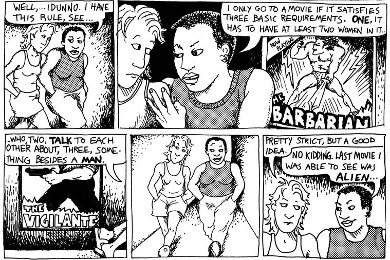
The Bechdel test — sometimes called the Bechdel-Wallace test — began as “a little lesbian joke in an alternative feminist newspaper” back in 1985. Posed in a comic strip by cartoonist Alison Bechdel, it asks three simple questions:
- Does the story have at least two women in it?
- Do they talk to each other?
- About something besides a man?
At first it seems a little silly — until you start looking at the data. In one study of almost 900 successful US films from 1950 to 2006, the ratio of male to female characters remained stable for more than half a century: 2:1. But women were portrayed as being involved in sex twice as often as their male counterparts.
A 2014 study of 120 films made worldwide showed only 31% of the named characters were women, a figure reflected in another study of 700 films made between 2007 and 2014. Only 30% of the speaking characters were women.
Why does this matter? According to US National Public Radio’s Neda Ulaby:
“it articulates something often missing in popular culture: not the number of women we see on screen, but the depth of their stories, and the range of their concerns.”
It’s still largely applied to films, but it’s equally applicable to books. Goodreads has lists of crime, SF, YA and general fiction that pass the Bechdel test and it’s also been applied to the classics.
The Finkbeiner test
The Finkbeiner test is a checklist to help journalists avoid gender bias in articles about women in science. Proposed in 2013 by Christie Aschwanden, a health columnist for the Washington Post, it was named after Ann Finkbeiner, one of her colleagues, who decided to write about an impressive astronomer and “not once mention that she’s a woman” because “when you emphasize a woman’s sex, you inevitably end up dismissing her science”.
The pair were concerned about this sort of thing:
“Jill makes a fantastic role model…because she is married, has two children and has been able to keep up with her research.”
(In a profile of biologist Jill Bargonetti in the New York Times.)
“No matter how much she bends time, there’s no escaping the fact that she’s just turned 43 and that if she wants to have kids she’s going to have to get on with it soon.”
(In a profile of pre-eminent physicist Lisa Randall in the Guardian.)
“She made a mean beef stroganoff, followed her husband from job to job and took eight years off from work to raise three children”
(The New York Times again, in an obituary of rocket scientist Yvonne Brill.)
So Aschwanden proposed seven rules for stories to pass the Finkbeiner test. The story cannot mention:
- The fact that she’s a woman
- Her husband’s job
- Her child care arrangements
- How she nurtures her underlings
- How she was taken aback by the competitiveness in her field
- How she’s such a role model for other women
- How she’s the “first woman to …”
She adds:
Here’s another trick. Take the things that are said about a female subject and flip them around as if they were said about a male. If they sound ridiculous, then chances are good they have no business in the story.
Apply that trick to the examples above and you’ll see exactly what she means!

